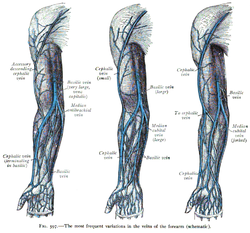| Cephalic vein | |
|---|---|
 Superficial veins of the upper limb | |
 The most frequent variations of the veins of the forearm | |
| Details | |
| Drains from | Dorsal venous network of hand |
| Drains to | Axillary vein and median cubital vein |
| Artery | Deltoid branch of thoracoacromial artery |
| Identifiers | |
| Latin | vena cephalica |
| TA98 | A12.3.08.015 |
| TA2 | 4964 |
| FMA | 13324 |
| Anatomical terminology | |
In human anatomy, the cephalic vein is a superficial vein in the arm. It originates from the radial end of the dorsal venous network of hand, and ascends along the radial (lateral) side of the arm before emptying into the axillary vein. At the elbow, it communicates with the basilic vein via the median cubital vein.
YouTube Encyclopedic
-
1/3Views:6 020173 97917 018
-
Cephalic Vein Made Easy
-
Superficial Veins of Upper Limb - Basilic & Cephalic veins | Anatomy Tutorial
-
Cephalic vein in less than 1 minute - Kenhub #shorts
Transcription
Anatomy
The cephalic vein is situated within the superficial fascia along the anterolateral surface of the biceps.[citation needed]
Origin
The cephalic vein forms over the anatomical snuffbox at the radial end of the dorsal venous network of hand.[1]: 983
Course and relations
From its origin, it ascends up the lateral aspect of the radius.[2]
Near the shoulder, the cephalic vein passes between the deltoid and pectoralis major muscles (deltopectoral groove) through the clavipectoral triangle, where it empties into the axillary vein.[citation needed]
Anastomoses
It communicates with the basilic vein via the median cubital vein at the elbow.[citation needed]
Clinical significance
The cephalic vein is often visible through the skin, and its location in the deltopectoral groove is fairly consistent, making this site a good candidate for venous access. Permanent pacemaker leads are often placed in the cephalic vein in the deltopectoral groove. The vein may be used for intravenous access, as large bore cannula may be easily placed. However, the cannulation of a vein as close to the radial nerve as the cephalic vein can sometimes lead to nerve damage.[medical citation needed]
History
Ordinarily the term cephalic refers to anatomy of the head. When the Persian Muslim physician Ibn Sīnā's Canon was translated into medieval Latin, cephalic was mistakenly chosen to render the Arabic term al-kífal, meaning "outer".[3][4]
Additional images
-
Cross-section through the middle of the forearm
-
The deep veins of the upper extremity
-
Cross-section through the middle of upper arm
(cephalic vein labeled at upper left) -
Cephalic vein
-
Cephalic vein
See also
References
- ^ Gray's anatomy : the anatomical basis of clinical practice. Susan Standring (Forty-second ed.). [New York]. 2021. ISBN 978-0-7020-7707-4. OCLC 1201341621.
{{cite book}}: CS1 maint: location missing publisher (link) CS1 maint: others (link) - ^ Gray's anatomy : the anatomical basis of clinical practice. Susan Standring (Forty-second ed.). [New York]. 2021. ISBN 978-0-7020-7707-4. OCLC 1201341621.
{{cite book}}: CS1 maint: location missing publisher (link) CS1 maint: others (link) - ^ Diab, Mohammad (1999). Lexicon of orthopaedic etymology. Taylor & Francis. p. 54. ISBN 978-90-5702-597-6.
- ^ Swenson, Rand. "Etymology of shoulder and arm terms". Dartmouth Medical School: © O'Rahilly 2008. Archived from the original on October 3, 2017. Retrieved April 20, 2011.
External links
- Anatomy photo:07:st-0702 at the SUNY Downstate Medical Center
- Radiology image: UpperLimb:18VenoFo from Radiology Atlas at SUNY Downstate Medical Center (need to enable Java)





